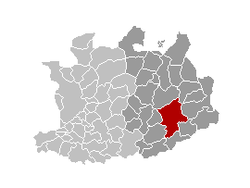Geel
| Geel | |||
|---|---|---|---|
| Municipality | |||
 |
|||
|
|||
| Location in Belgium | |||
| Coordinates: 51°10′N 05°00′E / 51.167°N 5.000°ECoordinates: 51°10′N 05°00′E / 51.167°N 5.000°E | |||
| Country | Belgium | ||
| Community | Flemish Community | ||
| Region | Flemish Region | ||
| Province | Antwerp | ||
| Arrondissement | Turnhout | ||
| Government | |||
| • Mayor | Vera Celis (N-VA) | ||
| • Governing party/ies | N-VA, CD&V | ||
| Area | |||
| • Total | 109.85 km2 (42.41 sq mi) | ||
| Population (1 January 2016) | |||
| • Total | 39,225 | ||
| • Density | 360/km2 (920/sq mi) | ||
| Postal codes | 2440 | ||
| Area codes | 014 | ||
| Website | www.geel.be | ||
Geel (Dutch pronunciation: [ɣeːl]) is a city located in the Belgian province of Antwerp, which acquired city status in the 1980s.
It comprises Central-Geel which is constituted of 4 old parishes a/o towns: Sint-Amand, Sint-Dimpna, Holven and Elsum. Further on around the center are the parish-towns of Ten Aard (N), Bel (E), Winkelomheide (SE), Stelen, Oosterlo and Zammel (S), Punt (SW) and Larum (W). On January 1, 2006, Geel had a total population of 35,189. The total area is 109.85 km2 (42 sq mi) which gives a population density of 320 inhabitants per km².
Geel’s patron saint, the Irish Saint Dymphna, inspired the town’s pioneering de-institutionalized method of care for the mentally ill. The city is also a regional hub of commerce and industry due to its location alongside the Albert Canal. Geel is also featured in Ciarán Carson's novel Shamrock Tea (Granta 2001).
Archeological finds in the area point to iron-age settlements, but the name of Geel (until mid-20th century spelled as Gheel) hails from a Germanic root meaning “yellow” and dates from the early Middle Ages. A hamlet already existed in the mid-13th century, at which time a certain Petrus Cameracencis, canon of Cambrai, wrote the Vita Sanctae Dimpnae (i.e., life of Saint Dymphna) set in Geel according to oral tradition. The cult of the saint attracted numerous pilgrims to the area, leading to a substantial population growth: 2,136 inhabitants in 1374.
...
Wikipedia




